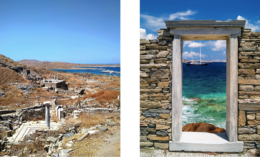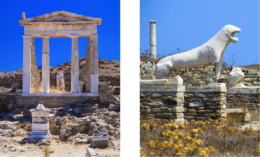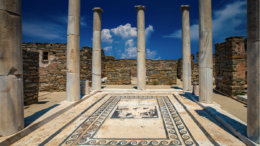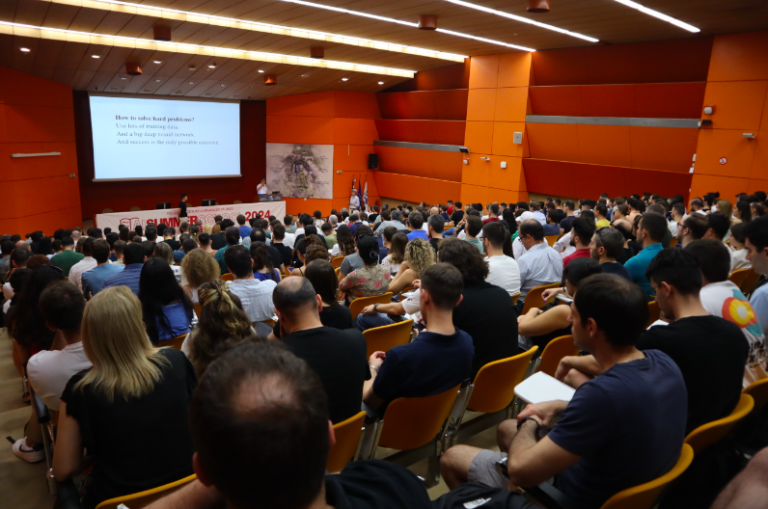The island that has attracted worldwide interest is located right in the centre of the Cyclades, in the heart of the Aegean Sea. According to mythology, two of the most important gods of the 12 Gods of Olympus, Artemis and Apollo, the most beautiful of the immortals, were born here.
For many, it is a key reason to choose Mykonos for their holidays as it is located only 2 miles from Mykonos, to the southwest.
Mythology has it that the god of light, Apollo, was born on the humble Aegean island, which has since become sacred. The worship of the god began as early as the Ionian era and continued throughout the centuries, with festivals, ceremonies, grand shrines, dedications of other Greek cities and more.

The precious treasure of the Delian Alliance was kept in Delos. Because of its strategic position in the Aegean, it developed particularly as a centre of navigation and trade when it was under the control of the Macedonians and then the Romans. It was then described as ‘the greatest trading centre of the world’.
A duty-free port, it was flooded with merchants and bankers, experienced incredible opulence, came to accommodate 25,000 people, and up to 10,000 slaves were sold from its slave markets in a day. The promise that Leto had made, to make Delos the richest place in the world, seems to have come true – with all that implies.
Mythology and history:
Invisible, that is to say, in Greek mythology, was the rocky islet that wandered in the waters of the Aegean. The myth is as follows: Zeus, father of the gods (unfaithful, as we has described) mated with Leto, daughter of Titan Koios and Phoebe. Zeus’s wife, the goddess Hera, envying the now pregnant Leto, persecuted her everywhere.
Leto now wandered about, hiding and seeking a place to give birth. Then Zeus asked Poseidon, god of the sea, to give Leto shelter. Poseidon then, following Zeus’s order, immobilised the ‘invisible island’ right in the middle of the Aegean. And it went from being invisible to Delos (visible). It was believed that it was tied with diamond chains to the bottom. And so Leto gave birth to her twin children there. Artemis, goddess of the hunt, and then Apollo, god of light and more beautiful than the immortals.
According to mythology, Leto had first given birth to Artemis, who even assisted her mother in giving birth to Apollo. The birth lasted 9 days and the pregnant woman’s agony ended when Eilithia, goddess of childbirth, arrived in Delos. As Homer has preserved the scene, the birth was particularly impressive.
A bright light spread over the island and the goddesses who stood by Leto were dazzled. Immediately a multitude of swans flew over the lake of Delos and the barren place blossomed. The island became sacred, bathed forever in the light of Apollo, and Leto promised to make Delos the richest place in the world.
According to Thucydides, the first settlers were the Cares. As the excavations show, people lived in Delos from the 3rd millennium BC (traces of circular calves were found on the top of Mount Kynthos).
In the Mycenaean period, and especially in the period 1580-1200 BC, Delos had a settlement on the plain near the port. Later, as in the rest of the Cyclades, the Ionians settled there. During the Geometric Age the island developed considerably.

From 700 BC we have references in Homer to the pan-septic Ionian Sanctuary of Apollo. Over the years it gained in prestige and respect and the Ionian cities dedicated rich votive offerings to it.
‘Delia’ was celebrated every four years with games, theatre, symposia, music and more.
In the ancient world they were the most famous games, after the Olympics and the Pythia.
Thucydides reports that the tyrant of Samos, Polycrates, gave the neighbouring island of Rhinia to Delos in 530 BC – and even connected it with a large chain to emphasise where the island belonged.
Later, the Athenians took a keen interest in Delos, as at the time their city was flourishing as a naval superpower. In 478 BC, after the end of the Persian wars, the Delian League was founded to protect the participating cities from future attacks.
The treasure of the alliance was kept in the temple of Apollo and administered by the Athenians. Thus, for the first time, the island was at the centre of ancient Greek history.

In 454 BC the treasure was transferred to the Acropolis of Athens, as the Athenians were showing hegemonic tendencies. However, the plague that broke out in the city during the Peloponnesian War was attributed to Apollo’s revenge for the Athenians’ attitude.
Thus, in 426-425 BC, Delos was cleansed: all the tombs were excavated, the bones of the dead and the grave goods were transported to the neighbouring Rhinia, in the so-called Catharsis crypt.
From then on, burials and births were forbidden in Delos, since both polluted the sanctuary.
Thus, the Delians, unable either to give birth or to be buried on their island, accepted exile from the Athenians who deported them to Adramuttium in Asia Minor, where most of them were exterminated by the Persians. After the Purification, the Athenians established a festival, in which every 5 years they sent a sacred ship with offerings to Delos.
They completed a magnificent temple to Apollo of Pentelic marble and another of limestone, which housed the god’s extravagantly large statue.
It was the period when the rulers of the Hellenistic states, as a show of power and wealth, offered money to build many important structures in Delos. People from all over the then known Greek world came to the island which was filled with statues.

In the reigns of Philip and Alexander the Great, Delos was freed from Athenian guardianship. In the period 314-166 BC the island developed greatly as the sanctuary was rationally administered by the Hieropoi (Delian rulers).
Realising its strategic position, as it was an ideal point for the transport of goods to Asia Minor and Egypt, the Macedonians were the first to develop it as a commercial centre.
General Antigonus, one of Alexander the Great’s successors, declared Delos free (314-166 BC) and created the Common of the Islanders with the sacred island as its religious centre, where wealthy businessmen and bankers settled.
Coming under the control of the Romans, from 168 BC onwards, they declared it a free port (without customs duties). In fact, as an inscription says, thanks to the Romans, Delos became ‘the greatest commercial centre of the world’. Rich merchants of Rome and people from all over Greece and the Mediterranean settled on the island.
Wealth and opulence unimaginable flooded the once holy island. Bankers and other tycoons lived here a glorious and dissolute life. Up to 750,000 tons of merchandise passed through its ports and around 100 B.C. 25,000 people lived on Delos – a picture that is very difficult to imagine today. Strabo says that at that time up to 10,000 slaves could come and be sold every day.
As is always the case in history, the cycle of prosperity had to come to an end, followed by one of decline. Being loyal to Rome, Delos was attacked by the Pontian king Mithridates of Eupatoros.
His fleet destroyed and sacked it in 88 BC, slaughtering 20,000 people in a single day. In 69 BC, Cilician pirates led by Athenodorus swept away what precious remains of the island.
In early Christian times, Delos became the seat of the bishop of the Cyclades, which included the islands of Mykonos, Syros, Serifos, Kythnos and Kea. In 1392 the Knights of Malta settled here. During the Turkish occupation, like Mykonos and the surrounding islands, it became a refuge for pirates.
Mitsotakis from Chios: Political stability is the stake of the European elections
And its ruins became a first-class source of building materials for the islanders.
Tourists such as the Arab Edrissi in the 12th century, and in 1445 Kyriakos from Ancona, considered one of the first archaeologists, visited Delos.
From the 17th century European historians came and made plans about the ruins of the glorious ancient city. Some of them, unfortunately, came simply to steal antiquities: thus, in the 17th century, one of the archaic lions of Delos ‘travelled’ to the Venice Naval Station, while other antiquities were smuggled to Rome and England.
The French School of Archaeology began excavations in 1873. From then until today, sanctuaries, theatres, rich houses with mosaics and frescoes have been uncovered, proving how important the civilisation that developed on the island of Delos was.
The most important discoveries were made between 1904 and 1914, when the excavations were directed by M. Holleaux and financed by the Duke de Loubat. Between 1958 and 1975 the excavation continued.
Monument maintenance and restoration work is constantly being carried out in Delos by the relevant Ephorate of Antiquities.
Very recently, underwater archaeological investigations were carried out in the large arm that protected the Holy Port and a shipwreck of the late Hellenistic period with amphorae was found.
Drawing on information from other shipwrecks found and dated to periods after the destruction of Delos (2nd-4th century AD), archaeologists conclude that the island had not ceased to be inhabited after all, but still played an important role in trade and navigation.
Ask me anything
Explore related questions





